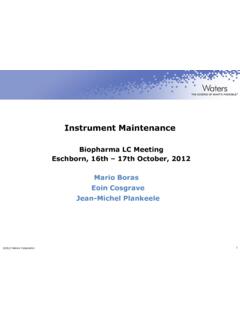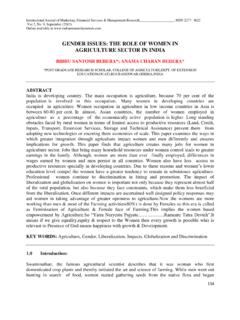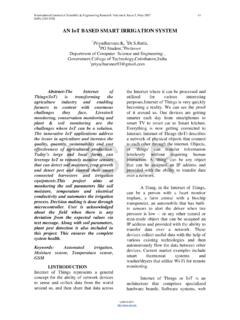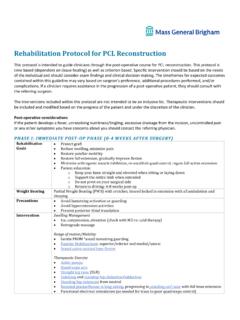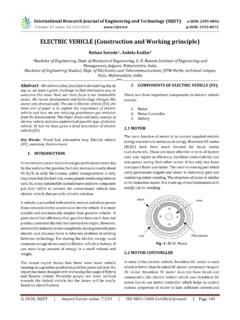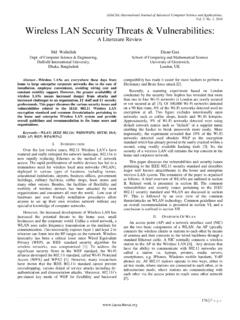Transcription of TRIPLE P – POSITIVE PARENTING PROGRAM - Home | ICTP
1 TRIPLE P POSITIVE PARENTING PROGRAM TRIPLE P INTRODUCTORY GUIDEU nited States Valid to 30 June 2020 TRIPLE P POSITIVE PARENTING PROGRAM 02To our valued collaborators,Building stronger and healthier communities in the United States and having those communities truly thrive is a vision shared by many. Yet, the challenges facing local communities are wide and varied and include poverty, violence, child abuse and neglect, education achievement disparity, poor physical and mental health, and anti-social behavior. The good news is that although the challenges are great, solutions are available to drastically improve the well-being of whole communities, and those solutions are backed by evidence to prove they work.
2 The TRIPLE P POSITIVE PARENTING PROGRAM can play its part in helping communities thrive and address the challenges mentioned above. TRIPLE P makes community-wide impacts by focusing on the smallest unit in the community the family to create POSITIVE changes for children and parents, with parents being empowered to take responsibility for their family. Those stronger families then make more POSITIVE and impactful contributions in the community. Understanding that financial resources are scarce and must be allocated towards what is proven to work, the TRIPLE P system has been developed (and independently verified) to save money for communities by focusing on prevention of problems before they arise. Further, the model offers parents the right amount of support at the right time and place and in the right dosage to be most effective nothing more and nothing less.
3 TRIPLE P has now been delivered in over 38 states and there are over 16,000 trained practitioners in the United States. Worldwide, there are more than 770 studies, trials, evaluation papers and meta-analyses about TRIPLE P, including more than 135 randomized controlled trials. The PROGRAM is recommended by the Centers for Disease control , American Academy of Pediatrics, and is ranked highly on evidence-based practice lists such as Blueprints for Healthy Youth Development, California Evidence-Based Clearinghouse for Child Welfare (CEBC), SAHMSA s National Registry for Evidence-based Programs Practices (NREPP), US Department of Justice s Crime Solutions, and Results First evidence is overwhelming. TRIPLE P works. It works at a child level including improvement in child behavior, social and emotional skills, increasing self-regulatory skills and improving health.
4 It works at a parent level, including reduction of parental stress, anxiety and depression. It works at a community level including reduction of out-of- home placements, child maltreatment injuries and child maltreatment cases, improving health and reducing juvenile justice cases, all of which save costs for communities and guide will take you further through what we do and how we do it. However, we are not the expert of your community you are. So, each implementing project is unique, as it should be. We would be honored to talk with you to explore how TRIPLE P might fit best within your community and how we could partner with you in helping your community thrive. Bradley ThomasChief Executive OfficerTriple P AmericaTRIPLE P INTERNATIONAL PTY LTD (AUSTRALIA) 11 Market Street North Indooroopilly QLD 1212 TRIPLE P INTERNATIONAL LTD (HONG KONG - WAREHOUSE) Unit A, 10/F, Roxy Industrial Centre, 58-66 Tai Lin Pai Road, Kwai Chung, Hong P NEW ZEALAND LTD Level 2, 15 Sultan Street, Ellerslie Auckland, New 1794 TRIPLE P UK LTD BM Box 9068, London WC1N 3XX, 2944 TRIPLE P AMERICA INC1201 Lincoln St, Suite 201 Columbia, SC, 29201, 2278 TRIPLE P LATAM LTDA (CHILE) Almirante Pastene 185, Depto 810, Providencia, Santiago, 4832 TRIPLE P PARENTING CANADA INCPO Box 36015 Wellington Postal Outlet Ottawa, ON, Canada K1Y P DEUTSCHLAND GMBH (GERMANY)Nordstra e 22 48149 M nster, FAMILIES FOUNDATION ( TRIPLE P NEDERLAND)
5 Koninginneweg 97, 1211 AP Hilversum, The Netherlands MORE INFORMATIONT riple P POSITIVE PARENTING PROGRAM 04 INDEXOVERVIEW 06 WHY IS PARENTING SO IMPORTANT? 07 Why introduce a PARENTING support strategy? 08 WHAT IS THE TRIPLE P SYSTEM? 09 Understanding the TRIPLE P system 09 The TRIPLE P evidence base 10 WHY INVEST IN TRIPLE P? 11A population health approach 11 Population-level impacts 12 Cost-effectiveness 13 Online variant 14 Intensive PARENTING support 14 Group programs across a community 15 Stepping Stones TRIPLE P 15 Long-term outcomes 15 Low- and middle-income countries 16 Going to scale 16 Effectiveness during maintenance 16 IMPLEMENTING TRIPLE P 17 TRIPLE P Implementation Framework 17 TRIPLE P Provider Network 18 ASRA 18 Additional support options 19 Stay POSITIVE Communications strategy 20 TRIPLE P PROVIDER TRAINING PROCESS 21 Entry-level requirements 21 Training 21 Pre-Accreditation 22 Accreditation 22 TRIPLE P POSITIVE PARENTING PROGRAM
6 05 This document contains information which is of a confidential nature. It is being provided to you on the understanding that you accept it and its contents as confidential and will disclose its contents only to those within your organization who have a need to see it. There should be no publication or reproduction of it in whole or part in any 2019 TRIPLE P International Pty LtdTraining outcome report 22 Additional training options 22 TRIPLE P DELIVERY 23 Staff commitment 23 TRIPLE P PROGRAM delivery resources 23 Translated resources 23 TRIPLE P Online 24 POSITIVE Early Childhood Education (PECE) PROGRAM 24 COSTS 251. TRIPLE P Provider Training Courses 252. Implementation support options 273. PROGRAM resources 284. TRIPLE P Online 305. Stay POSITIVE Communications strategy 316. POSITIVE Early Childhood Education PROGRAM 32 ADDITIONAL CONSIDERATIONS 33 Travel and accommodation 33 Observer 33 Venue 33 Copyright materials for purchase 33 TRIPLE P published resource orders 34 Letter of Agreement 34 Cancellation of training 34 Rescheduling of training 34 Cancellation and rescheduling of travel arrangements 34 Payment timing and form 34 APPENDIX A 35 APPENDIX B 39 TRIPLE P POSITIVE PARENTING PROGRAM 06 The TRIPLE P POSITIVE PARENTING PROGRAM ( TRIPLE P) is one of the most effective and best-known POSITIVE PARENTING systems in the world.
7 Its range of programs gives parents simple, practical strategies to build strong, healthy relationships, confidently manage children s behavior and prevent problems relation to TRIPLE P, the word parent refers to any person who is a biological parent, adoptive parent, guardian, caregiver, or who is otherwise acting in a parental who participate in TRIPLE P set their own goals and use the strategies and skills in their own style. With varying levels of support available, TRIPLE P can be tailored to the needs of every family situation providing for those who need a lot of support as well as those who need only a little. The TRIPLE P system is a suite of interventions of increasing intensity for families with children aged up to 16 years. Each level of the system can be delivered in a range of ways including one-to-one, small groups, large groups, or online.
8 TRIPLE P PROGRAM and support packages are available for individual practitioners, organizations, and population-based implementations involving multiple cross-sector TRIPLE P Implementation Framework (TPIF) provides guidance for those implementing TRIPLE P and follows the key principles of TRIPLE P self-regulation and minimal sufficiency. Using the TPIF, TRIPLE P Implementation Consultants (ICs) work in partnership with organizations to ensure that the implementation process is smooth, timely, and responds to the needs and constraints of the implementing organization and almost a decade, TRIPLE P America Inc. (TPA) has partnered with governments, agencies and nonprofits, and helped individual practitioners to get the best results from their family support initiatives.
9 TPA uses its knowledge and experience of the TRIPLE P system and its delivery, to support agencies and individuals as they plan for, train in and implement TRIPLE P. TPA is a Certified B Corporation . Certified B Corps meet the highest standards of social and environmental performance, transparency and influences all aspects of children s development. The day-to-day, moment-to-moment interactions between parents and their children have a sustained impact on children s well-being and quality of life. The POSITIVE PARENTING advantage cascades to all facets of life, including mental and physical health, learning opportunities, peer and couple relationships and work principles of TRIPLE P Minimal Sufficiency: providing the least intensive solution to a problem.
10 Self-Regulation: the capacity to solve problems fl flfi flTriple P POSITIVE PARENTING PROGRAM 07 The Dunedin Study1 followed a cohort of 1,037 children from birth (born 1972-1973). After almost 40 years, the study found the level of a child s self- control (first measured at age 3) predicted their health, wealth and criminality at age 32. Children who had low self- control showed higher rates at age 38 of: Metabolic abnormalities ( obesity, blood pressure, cholesterol). Periodontal disease, stroke and neurovascular disease. Dependence on tobacco, alcohol, cannabis and other illegal substances. Criminal also earned less money, were less orientated towards saving and had accrued fewer assets than the high self- control participants.

